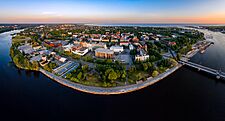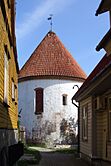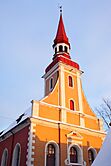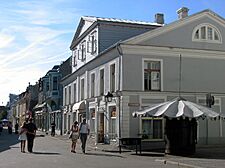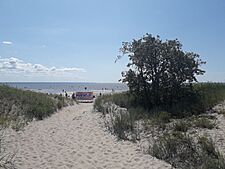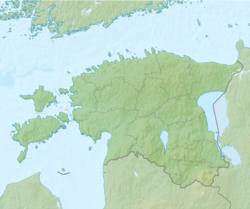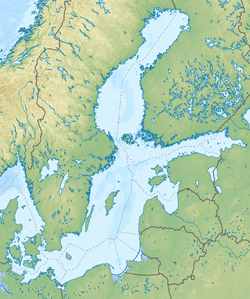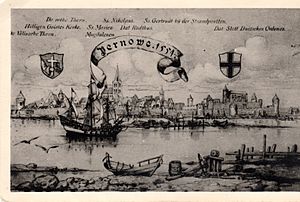Pärnu facts for kids
Quick facts for kids
Pärnu
Pärnu linn
City of Pärnu |
|
|---|---|
|
City
|
|
|
Pärnu
|
|
| Country | Estonia |
| County | Pärnu County |
| Municipality | Pärnu |
| Founded | 1251 |
| Area | |
| • Total | 32.22 km2 (12.44 sq mi) |
| Elevation | 10 m (30 ft) |
| Population
(2022)
|
|
| • Total | 40,228 |
| • Rank | 4th |
| • Density | 1,248.54/km2 (3,233.7/sq mi) |
| Ethnicity (2021) | |
| • Estonians | 83.7% |
| • Russians | 10.6% |
| • other | 5.7% |
| Time zone | UTC+2 (EET) |
| • Summer (DST) | UTC+3 (EEST) |
| Vehicle registration | F |
Pärnu is the fourth-largest city in Estonia. It is located in southwest Estonia, about 128 kilometers (80 miles) south of the capital city, Tallinn. Pärnu sits on the coast of Pärnu Bay, which is part of the Baltic Sea. The Pärnu River flows through the city and into the bay.
Pärnu is a very popular place for summer holidays. Many Estonians and tourists visit its hotels, restaurants, and large beaches. The city also has its own airport, Pärnu Airport.
Contents
History of Pärnu: A Journey Through Time
The original town, called Old Pärnu, was founded around 1251 by a bishop. However, it faced challenges from another nearby town and was eventually destroyed around 1600.
A new town, later known as Pärnu, was started by the Livonian Order in 1265. This new town, called Pernau in German, became an important port. It was a member of the Hanseatic League, which was a powerful group of trading cities in Northern Europe. Pärnu's port was special because it didn't freeze in winter, making it useful for trade all year.
Over the centuries, different powers controlled Pärnu. The Polish–Lithuanian Commonwealth ruled it between 1560 and 1617. Then, Sweden took control during the 16th-century Livonian War. Sweden officially gained the town in 1660.
However, Sweden lost Livonia, including Pärnu, to the Russian Empire after the Great Northern War in 1710. Pärnu remained part of Russia until 1917.
The city became part of independent Estonia in 1918, after World War I and the Estonian War of Independence.
During World War II, Pärnu was occupied by the Soviet Union in 1940. Many German people living there left the city. It was then briefly occupied by Nazi Germany from 1941 to 1944. After that, the Soviet Union took control again. Pärnu was part of the Estonian Soviet Socialist Republic until Estonia became independent once more in 1991.
Interestingly, the University of Dorpat (now Tartu) moved to Pärnu from 1699 to 1710 during the Great Northern War. Today, the university still has a branch campus in Pärnu.
Geography of Pärnu
Districts of Pärnu City
Pärnu is divided into seven main areas, or districts. These are Ülejõe, Rääma, Vana-Pärnu, Kesklinn, Rannarajoon, Eeslinn, and Raeküla.
Pärnu's Climate
Pärnu has a temperate humid continental climate. This means it has four distinct seasons, with warm summers and cold, snowy winters.
| Climate data for Pärnu (normals 1991–2020, extremes 1842–present) | |||||||||||||
|---|---|---|---|---|---|---|---|---|---|---|---|---|---|
| Month | Jan | Feb | Mar | Apr | May | Jun | Jul | Aug | Sep | Oct | Nov | Dec | Year |
| Record high °C (°F) | 9.0 (48.2) |
8.3 (46.9) |
19.6 (67.3) |
26.2 (79.2) |
31.2 (88.2) |
32.6 (90.7) |
34.1 (93.4) |
33.4 (92.1) |
28.0 (82.4) |
22.4 (72.3) |
12.6 (54.7) |
10.3 (50.5) |
34.1 (93.4) |
| Mean daily maximum °C (°F) | −0.8 (30.6) |
−1 (30) |
3.0 (37.4) |
10.2 (50.4) |
16.7 (62.1) |
20.2 (68.4) |
23.0 (73.4) |
21.8 (71.2) |
16.6 (61.9) |
9.9 (49.8) |
4.3 (39.7) |
1.1 (34.0) |
10.4 (50.7) |
| Daily mean °C (°F) | −3.0 (26.6) |
−3.7 (25.3) |
−0.5 (31.1) |
5.4 (41.7) |
11.4 (52.5) |
15.4 (59.7) |
18.3 (64.9) |
17.2 (63.0) |
12.5 (54.5) |
6.8 (44.2) |
2.2 (36.0) |
−0.9 (30.4) |
6.8 (44.2) |
| Mean daily minimum °C (°F) | −5.5 (22.1) |
−6.6 (20.1) |
−3.7 (25.3) |
1.2 (34.2) |
6.1 (43.0) |
10.7 (51.3) |
13.6 (56.5) |
12.8 (55.0) |
8.6 (47.5) |
3.8 (38.8) |
0.0 (32.0) |
−3.1 (26.4) |
3.2 (37.8) |
| Record low °C (°F) | −34.8 (−30.6) |
−34.3 (−29.7) |
−28.5 (−19.3) |
−19.7 (−3.5) |
−5.3 (22.5) |
−0.1 (31.8) |
3.4 (38.1) |
2.6 (36.7) |
−4.7 (23.5) |
−10.9 (12.4) |
−22.2 (−8.0) |
−34.5 (−30.1) |
−34.8 (−30.6) |
| Average precipitation mm (inches) | 61 (2.4) |
49 (1.9) |
43 (1.7) |
40 (1.6) |
39 (1.5) |
78 (3.1) |
74 (2.9) |
84 (3.3) |
61 (2.4) |
83 (3.3) |
73 (2.9) |
71 (2.8) |
761 (30.0) |
| Average precipitation days (≥ 1.0 mm) | 12.6 | 10.4 | 9.5 | 8.4 | 7.7 | 9.7 | 9.6 | 10.4 | 9.6 | 12.2 | 13.5 | 14.0 | 127.6 |
| Average relative humidity (%) | 88 | 87 | 81 | 73 | 68 | 73 | 75 | 78 | 82 | 86 | 89 | 89 | 81 |
| Mean monthly sunshine hours | 38.8 | 69.6 | 148.2 | 210.1 | 300.3 | 293.5 | 306.4 | 258.6 | 172.8 | 95.5 | 36.5 | 24.3 | 1,950.2 |
| Source: Estonian Weather Service | |||||||||||||
| Coastal temperature data for Pärnu | |||||||||||||
|---|---|---|---|---|---|---|---|---|---|---|---|---|---|
| Month | Jan | Feb | Mar | Apr | May | Jun | Jul | Aug | Sep | Oct | Nov | Dec | Year |
| Average sea temperature °C (°F) | 0.4 (32.72) |
0.0 (32.00) |
-0.1 (31.82) |
1.9 (35.42) |
7.7 (45.86) |
14.7 (58.46) |
19.4 (66.92) |
19.1 (66.38) |
15.9 (60.62) |
10.7 (51.26) |
6.7 (44.06) |
3.6 (38.48) |
8.3 (47.00) |
| Source 1: Seatemperature.org | |||||||||||||
Rivers and Bays in Pärnu
Pärnu is home to several important water bodies. These include the Pärnu River, Sauga River, Reiu River, and Pärnu Bay.
The Pärnu Moat was once part of the Pärnu Fortress. Today, it is a popular spot for different events and activities.
Who Lives in Pärnu? (Demographics)
Pärnu is a diverse city with people from many backgrounds. Most residents are Estonians, but there are also many Russians and people from other countries.
| Year | 1881 | 1897 | 1922 | 1934 | 1959 | 1970 | 1979 | 1989 | 2000 | 2011 | 2012 | 2017 | 2021 |
|---|---|---|---|---|---|---|---|---|---|---|---|---|---|
| Population | 12,966 | 12,898 | 18,499 | 20,334 | 22,367 | 50,224 | 54,051 | 53,885 | 45,500 | 39,728 | 40,401 | 40,700 | 40,228 |
| Ethnicity | 1922 | 1934 | 1941 | 1959 | 1970 | 1979 | 1989 | 2000 | 2011 | 2021 | ||||||||||
|---|---|---|---|---|---|---|---|---|---|---|---|---|---|---|---|---|---|---|---|---|
| amount | % | amount | % | amount | % | amount | % | amount | % | amount | % | amount | % | amount | % | amount | % | amount | % | |
| Estonians | 16440 | 89.0 | 18436 | 90.7 | 18370 | 96.7 | 26669 | 73.9 | 34370 | 74.2 | 36748 | 74.1 | 37939 | 72.4 | 36112 | 79.4 | 33000 | 83.1 | 33682 | 83.7 |
| Russians | 494 | 2.67 | 469 | 2.31 | 328 | 1.73 | - | - | 9146 | 19.7 | 9676 | 19.5 | 10753 | 20.5 | 6951 | 15.3 | 5076 | 12.8 | 4256 | 10.6 |
| Ukrainians | - | - | 7 | 0.03 | - | - | - | - | 1010 | 2.18 | 1255 | 2.53 | 1631 | 3.11 | 966 | 2.12 | 671 | 1.69 | 887 | 2.20 |
| Belarusians | - | - | - | - | - | - | - | - | 412 | 0.89 | 493 | 0.99 | 546 | 1.04 | 297 | 0.65 | 179 | 0.45 | 184 | 0.46 |
| Finns | - | - | 14 | 0.07 | 11 | 0.06 | - | - | 517 | 1.12 | 543 | 1.09 | 534 | 1.02 | 331 | 0.73 | 254 | 0.64 | 324 | 0.81 |
| Jews | 236 | 1.28 | 248 | 1.22 | 0 | 0.00 | - | - | 190 | 0.41 | 138 | 0.28 | 76 | 0.15 | 35 | 0.08 | 20 | 0.05 | 13 | 0.03 |
| Latvians | - | - | 143 | 0.70 | 88 | 0.46 | - | - | 135 | 0.29 | 165 | 0.33 | 150 | 0.29 | 85 | 0.19 | 65 | 0.16 | 128 | 0.32 |
| Germans | 1030 | 5.57 | 871 | 4.28 | - | - | - | - | - | - | 105 | 0.21 | 132 | 0.25 | 69 | 0.15 | 50 | 0.13 | 55 | 0.14 |
| Tatars | - | - | 0 | 0.00 | - | - | - | - | - | - | 76 | 0.15 | 103 | 0.20 | 45 | 0.10 | 33 | 0.08 | 31 | 0.08 |
| Poles | - | - | 34 | 0.17 | 26 | 0.14 | - | - | - | - | 108 | 0.22 | 81 | 0.15 | 60 | 0.13 | 35 | 0.09 | 37 | 0.09 |
| Lithuanians | - | - | 10 | 0.05 | 6 | 0.03 | - | - | 60 | 0.13 | 80 | 0.16 | 83 | 0.16 | 82 | 0.18 | 60 | 0.15 | 58 | 0.14 |
| unknown | 0 | 0.00 | 28 | 0.14 | 8 | 0.04 | 0 | 0.00 | 0 | 0.00 | 0 | 0.00 | 0 | 0.00 | 226 | 0.50 | 59 | 0.15 | 129 | 0.32 |
| other | 281 | 1.52 | 74 | 0.36 | 167 | 0.88 | 9398 | 26.1 | 476 | 1.03 | 236 | 0.48 | 361 | 0.69 | 241 | 0.53 | 226 | 0.57 | 444 | 1.10 |
| Total | 18481 | 100 | 20334 | 100 | 19004 | 100 | 36067 | 100 | 46316 | 100 | 49623 | 100 | 52389 | 100 | 45500 | 100 | 39728 | 100 | 40228 | 100 |
Pärnu's Economy: How the City Works
Today, Pärnu has a strong and balanced economy. It has many different types of businesses and industries. New companies and foreign investments have helped create jobs and make businesses more competitive around the world. Some companies in the Pärnu region are even among the best in Estonia.
The Port of Pärnu, located where the Pärnu River meets the sea, is very important. Many goods from Pärnu and southern Estonia are shipped from this port. In recent years, it has become a key harbor for the region.
Pärnu has been famous as a place for relaxation and holidays since the mid-1800s. The first bathing facility opened in 1838, which is seen as the start of Pärnu's resort history. Now, Pärnu has everything a modern holiday resort needs. This includes spas, rehabilitation centers, hotels, places for conferences and concerts, golf courses, tennis courts, restaurants, and pubs. Because of its long history as a resort, Pärnu is well-known in Finland and other Scandinavian countries.
Tourism and Fun in Pärnu
Most tourists visiting Pärnu come from Finland, Sweden, and Russia. More and more visitors are also coming from Germany, Latvia, and Norway.
In 1837, a building near the beach was turned into a bathing spot. It had several bathrooms where people could enjoy hot seawater baths in summer. In winter, it worked as a sauna. The original wooden building was destroyed during World War I. In 1927, the current stone building, known as Pärnu Mud Baths, was built in the same place.
Since 1996, Pärnu has been known as Estonia's "Summer Capital." This means it's a top destination for summer fun!
Since 2015, Pärnu has hosted the annual Weekend Festival. This is one of the biggest dance music festivals in the Nordic and Baltic regions. Famous DJs from around the world perform here, with amazing lights and sounds. Some of the artists who have played or will play include Martin Garrix, David Guetta, Avicii, Steve Aoki, The Chainsmokers, and Tiësto.
Pärnu is also famous for its seawall. There's a local legend that says if a couple walks hand-in-hand along the wall and kisses at the very end, they will stay together forever.
Notable People from Pärnu

Many talented people have come from Pärnu. Here are some of them:
- Elisabeth Aspe, a writer
- Gustav Fabergé, a famous jeweller
- Johann Voldemar Jannsen, a journalist and poet
- Lili Kaelas, an archeologist
- Tõnis Kasemets, a race-car driver
- Egon Kaur, a rally driver
- Paul Keres, a chess grandmaster
- Lydia Koidula, a poet
- Ilmi Kolla, a poet
- Kaie Kõrb, a prima ballerina
- Karin Luts, an artist
- Friedrich Martens, a lawyer
- Kaili Närep, an actress
- Rene Pais, also known as Syn Cole, a DJ and musician
- Liisa Pulk, an actress
- Rasmus Rändvee, a singer
- Salme Reek, an actress
- Georg Wilhelm Richmann, a German physicist
- Erika Salumäe, a track bicycle racer
- David Samoylov, a poet
- August Sang, a poet
- Olev Siinmaa, an architect
- David Shrayer-Petrov, a poet, writer, translator, and medical scientist
- Maxim D. Shrayer, an author and literary scholar
- Lilli Suburg, a writer
- Avo Sõmer, a musicologist, music theorist, and composer
- Kristin Tattar, an athlete and disc golf world champion
Honorary Citizens of Pärnu
Pärnu has also given special recognition to these people:
- 1886 Konstantin Possiet
- 1901 Friedrich Fromhold Martens
- 1934 Konstantin Päts
- 2007 Neeme Järvi
- 2008 Valter Ojakäär
- 2009 Jüri Jaanson
Images for kids
See also
 In Spanish: Pärnu para niños
In Spanish: Pärnu para niños


